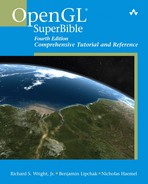Preface to the Previous, Third Edition
I have a confession to make. The first time I ever heard of OpenGL was at the 1992 Win32 Developers Conference in San Francisco. Windows NT 3.1 was in early beta (or late alpha), and many vendors were present, pledging their future support for this exciting new graphics technology. Among them was a company called Silicon Graphics, Inc. (SGI). The SGI representatives were showing off their graphics workstations and playing video demos of special effects from some popular movies. Their primary purpose in this booth, however, was to promote a new 3D graphics standard called OpenGL. It was based on SGI’s proprietary IRIS GL and was fresh out of the box as a graphics standard. Significantly, Microsoft was pledging future support for OpenGL in Windows NT.
I had to wait until the beta release of NT 3.5 before I got my first personal taste of OpenGL. Those first OpenGL-based screensavers only scratched the surface of what was possible with this graphics API. Like many other people, I struggled through the Microsoft help files and bought a copy of the OpenGL Programming Guide (now called simply “The Red Book” by most). The Red Book was not a primer, however, and it assumed a lot of knowledge that I just didn’t have.
Now for that confession I promised. How did I learn OpenGL? I learned it by writing a book about it. That’s right, the first edition of the OpenGL SuperBible was me learning how to do 3D graphics myself...with a deadline! Somehow I pulled it off, and in 1996 the first edition of the book you are holding was born. Teaching myself OpenGL from scratch enabled me somehow to better explain the API to others in a manner that a lot of people seemed to like. The whole project was nearly canceled when Waite Group Press was acquired by another publisher halfway through the publishing process. Mitchell Waite stuck to his guns and insisted that OpenGL was going to be “the next big thing” in computer graphics. Vindication arrived when an emergency reprint was required because the first run of the book sold out before ever making it to the warehouse.
That was a long time ago, and in what seems like a galaxy far, far away...
Only three years later 3D accelerated graphics were a staple for even the most stripped-down PCs. The “API Wars,” a political battle between Microsoft and SGI, had come and gone; OpenGL was firmly established in the PC world; and 3D hardware acceleration was as common as CD-ROMs and sound cards. I had even managed to turn my career more toward an OpenGL orientation and had the privilege of contributing in some small ways to the OpenGL specification for version 1.2 while working at Lockheed-Martin/Real 3D. The second edition of this book, released at the end of 1999, was significantly expanded and corrected. We even made some modest initial attempts to ensure that all the sample programs were more friendly in non-Windows platforms by using the GLUT framework.
Now, nearly five years later (eight since the first edition!), we bring you yet again another edition, the third, of this book. OpenGL is now without question the premier cross-platform real-time 3D graphics API. Excellent OpenGL stability and performance are available on even the most stripped-down bargain PC today. OpenGL is also the standard for UNIX and Linux operating systems, and Apple has made OpenGL a core fundamental technology for the new Mac OS X operating system. OpenGL is even making inroads via a new specification, OpenGL ES, into embedded and mobile spaces. Who would have thought five years ago that we would see Quake running on a cellphone?
It is exciting that, today, even laptops have 3D acceleration, and OpenGL is truly everywhere and on every mainstream computing platform. Even more exciting, however, is the continuing evolution of computer graphics hardware. Today, most graphics hardware is programmable, and OpenGL even has its own shading language, which can produce stunningly realistic graphics that were undreamed of on commodity hardware back in the last century (I just had to squeeze that in someplace!).
With this third edition, I am pleased that we have added Benjamin Lipchak as a co-author. Benj is primarily responsible for the chapters that deal with OpenGL shader programs; and coming from the ARB groups responsible for this aspect of OpenGL, he is one of the most qualified authors on this topic in the world.
We have also fully left behind the “Microsoft Specific” characteristics of the first edition and have embraced a more multiplatform approach. All the programming examples in this book have been tested on Windows, Mac OS X, and at least one version of Linux. There is even one chapter apiece on these operating systems, with information about using OpenGL with native applications.
—Richard S. Wright Jr.
